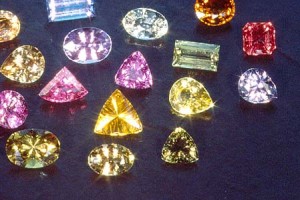40 fascinating jewellery facts
- What is the oldest known jewellery ever found? 100,000-year-old beads made from Nassarius shells.
- The word jewellery comes from jewel, from the old French jouel, which in turn comes from the latin jocale, which means ‘plaything’.
- The Americans call it jewelry, everyone else calls it jewellery.
-
In many cultures jewellery is supposed to ward off evil, for example the famous Egyptian ankh.
- Through history live insect jewellery has been popular. The Egyptians may have been the first to do so, wearing scarab beetles into battle. But the Mexican Maquech Beetle and Giant Madagascar Hissing Cockroach have also been used in jewellery. In Britain the Victorians loved it, often sporting huge, vivid live beetles attached to their clothing by tiny, fine gold chains.
- 24 carat gold is 99.9% pure, and most US and European jewellers think it’s too soft for jewellery. But 24 carat gold is the norm across Asia, the Middle East and Africa.
- Platinum alloys range from 900 (90% pure) to 950 (95% pure).
- Venetian glass masters on the island of Murano developed crystalline glass, enamelled glass, glass including gold threads and a load more creative and revolutionary ways to make stunning glass beads. Venetian glass necklaces were sought after as early as the 1200s and are still made today.
- Diamonds were first mined in India.
-
The British crown jewels include the massive Cullinan Diamond, a chunk of the biggest ever gem-quality rough diamond ever found. It was discovered in 1905 and weighed 3,106.75 carats, which translates to 621.35g in weight. Blimey, that’s what we call bling!
- Engagement rings date back to 1477, first popularised by the marriage of Maximilian the 1st to Mary of Burgundy.
- Amber, an organic gem, is made of fossilised tree resin. It must be at least a million years old to qualify as amber, but there are plenty of composite and reconstituted resin alternatives around, cheap as chips and NOT the real thing. If the price is too good to be true, it isn’t amber.
- Amber can be as old as 120 million years.
- Amethyst is just a version of quartz, but its beautiful purple colour makes it a popular semi-precious gem for jewellery. Rose quartz, smoky quartz and citrine are also popular.
- Emeralds were mined by the Egyptians as early as 3500 BC.
- Jade is sometimes called ‘the stone of heaven’.
- A large, perfect, gem quality ruby is worth more than a similar sized diamond.
- In the Indian language of Sanskrit, the word for ruby isratnaraj, which means ‘king of precious stones’.
-
The most popular form of sapphire is blue, but you can get ‘fancy’ sapphires in other colours.
- Turquoise is only found in only a few places, the biggest region being the south western USA. Turquoise is associated with traditional Native American jewellery as well as modern jewellery.
- What is an organic gemstone? Organic means substances like pearls, coral and amber, all made by living organisms rather than created through natural geological processes.
- Throughout history, jewellery has often been about status. In ancient Rome, for example, only some high ranking people were allowed to wear rings.
- In the west, men wearing earrings were seen as effeminate in the 19th and most of the 20th centuries. Now, it’s perfectly acceptable.
- In some African cultures enormous earrings are a sign of masculinity, prowess, power and status.
- Wedding rings for men are a 20th century thing, a practice launched by the jewellery industry to increase sales and double their market reach.
- By the mid 1940s, 85% of north American weddings involved rings for both partners.
- In traditional Islam, the wearing of gold by men is a social taboo and women can only wear ear jewellery.
- The Christian bible is against the wearing of gold, namely in the writings of the apostles Paul and Peter. And in Revelations 17 “the great whore” – AKA a religious system the bible disapproved of – was seen as “decked with gold and precious stones and pearls, having a golden cup in her hand.” Luckily nobody takes much notice of such nonsense these days, or we wouldn’t have a business!
- Snail shell beads found in Africa date back 75,000 years, discovered in the ancient Blombos Cave.
- More beads, made from ostrich egg shell, have been found in Kenya’s Enkapune Ya Muto and date back more than 40,000 years.
- Our Cro-Magnon ancestors wore simple necklaces and bracelets made from bone, teeth, berries and stones threaded on string or animal sinew.
- Ancient carved bracelets made from mammoth tusk have been found in Russia.
- Copper jewellery started appearing about 7000 years ago. The Museum of Ancient History in Lower Austria found a female jeweller’s grave, dispelling the long-held assumption that in ancient times, jewellers were always male.
- Jewellery appeared in Ancient Egypt between 3000-5000 years ago. They loved gold best.
-
Mesopotamia tombs at the Royal Cemetery of Ur, dating back to 2900–2300 BC, were stuffed with gorgeous gold, silver and semi-precious stone-studded jewellery including amazing lapis lazuli and gold crowns, collars and pins.
- In ancient Assyria, men and women wore absolutely huge amounts of jewellery including amulets, ankle bracelets and massive multi-strand necklaces.
- The Indians have been making fine jewellery for more than 5000 years, an obsession kicked off by the Indus Valley Civilization.
- People started making jewellery in China around the same time, but it didn’t become widespread until Buddhism started to gain popularity about 2000 years ago.
- The ancient Chinese loved silver much more than gold, using the metal to craft beautiful pieces studded with blue kingfisher feathers and various blue gemstones. But their main obsession was with jade, which they loved for its alleged human qualities: hardness, durability and beauty
- In the early 1980s The Smiths popularised jewellery for men, reviving a hippy trend from the 1960s. In a then-sexist Britain, it was a bit of a shock to see men wearing ropes of beaded and jewelled necklaces, and even wielding bunches of beautiful flowers in nightclubs and pubs. Well done, Morrissey!





